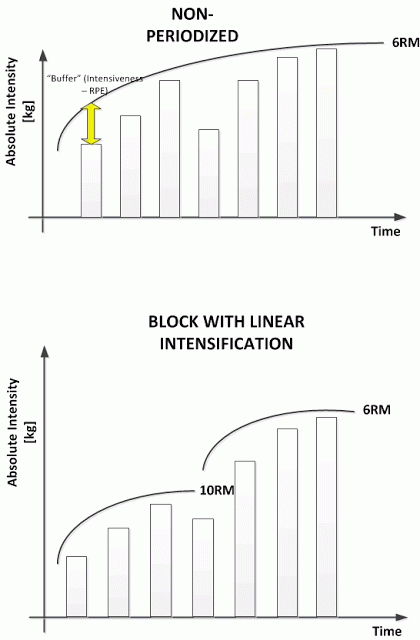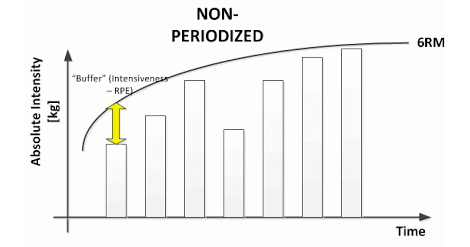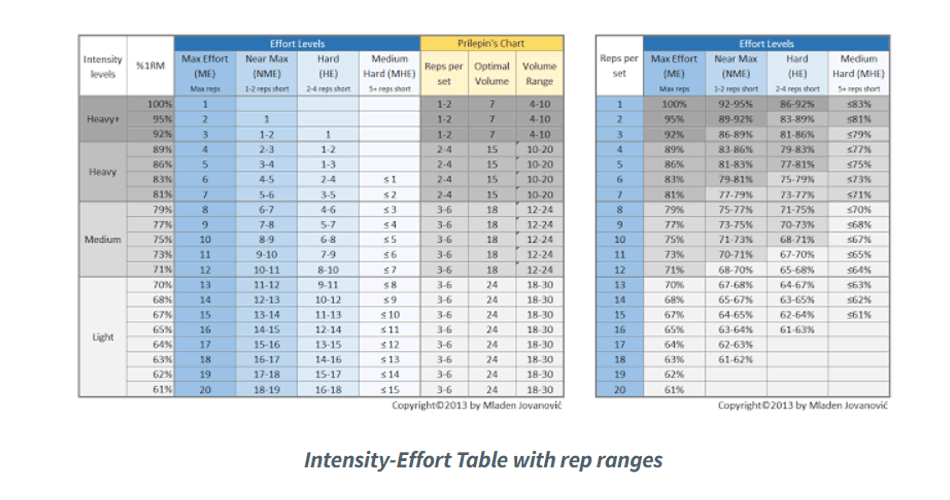Random Thoughts From the Training Camp [Part 2]
Here is the second part of random thoughts from training camps.
Strength training
I’ve been reading Dan Baker’s articles regarding strength training and conditioning and I have found one old one (from 1994) especially interesting: Periodization: The Effect on Strength of Manipulating Volume and Intensity.
One of the conclusions of this paper was that:
Over a short training cycle, non-periodized strength training results in the same gains as does linear and undulating periodized strength training, when training volume and relative intensity are equated
This non-periodized strength training is simple 5×6 training program, where linear is 5×10 to 3×3 (please read the full article). This 5×6 is very similar to Starting Strength 3×5 or Bill Starr’s 5×5 which are both non-periodized (for more info please read Planning the Strength Training articles). The question is what is the rationale behind more complex rep/set alternations (or Cycle-Length Variants as Dan Baker use to call them)? I think I gave pretty much extensive answer to that question in Planning the Strength Training and What the Heck is Periodization Anyway, but I would love to present another ‘paradigm’ behind it.
Why would one need to progress from 10 reps to 3 reps, when doing a simple non-periodized strength program may yield same training effect (over a short cycle for beginner/intermediate athletes)? If we take ‘repetition continuum’ (anatomic adaptation zone, hypertrophy zone, relative strength zone) out of equation, I think that we are dealing with training potential (please take a look at SST: Manual for Coaches) of certain percentage of 1RM. From the principle of using the least amount of training load to bring up the adaptation, the beginner and someone coming from off-season will yield same (or almost the same) adaptations (in terms of strength improvement) by utilizing the 70% or 95% of 1RM, while the 70% will be a lot safer and done with better technique. The greater the intensity/intensiveness the quicker the results, but also the quicker the stagnation and shorter the residual training effects. Easy come, easy go. Just my 2 cents on the issue.

Training potential of different training means
Another interesting topic is intensiveness of training and build~test concept. In short, intensiveness is how hard the set feels or should I say proximity of failure or true RM (repetition maximum) and it is usually expressed as RPE number. Training programs utilize certain Cycle-Length variations that ‘plays’ with loading parameters (intensity, reps, sets, volume, rest, etc), but I guess the real rationale behind is the progression in intensiveness even for non-periodized programs (like 5×5, where once you stagnate you reduce the intensity for 20% and start all over, for example).
First you start easy, you build and you peak. Rinse and repeat. If you keep pushing it, you will need to do training for the broken. What I want to say is that on the fundamental level programs progress from easy to hard. These are intensiveness concepts.

Progression in intensiveness
This concept goes pretty well with every training program out there. Take 5/3/1 for example. You start easy with 10% reduction in your 1RM. Even if the last set for key movement is usually done for max reps (RPE 10), this can be ‘cycled’ too, by “picking up your battles” (as stated by Jim Wendler in the new 5/3/1 for Powerlifting). When you start to struggle, you reduce 1RM for 10% and start all over. Rinse and repeat. You cannot force adaptation, you need to take it into account.
The point being taken here is that we have certain ‘limited energy’ for doing intensive work before we burn-out and stagnate. I think this is substance principle of all form programs (substance~form complementary pair) and it is principle behind all training programs (construct in construct~constraints). The question is how this fundamental principle evolves as the lifter advances and how it affects his planning (based on his level). For example, beginners can do intensive training for all exercises in certain workout. Intermediates need to pick their battle within the workout in terms which exercise(s) are they going to push real hard. Advanced need to do that too, but also needs to choose during what days are they going to do it. Elites have short periods during which they are able to spend their ‘limited energy’ to push key exercises. More on this can be found in Planning the Strength Training.
In my opinion this can be applied to Build~Test complementary pair. Building strength and testing strength is not the same. As Jim Wendler said, if it was the same, then all you would need to do is do a meet every day. Smart guy that Jim. And strong. Damn strong.
Building strength demands certain volume and less intensiveness. Please note that I didn’t say less intensity, but lower intensiveness. Lower intensiveness will allow you more volume. Testing strength demands very small volume and high intensiveness. Both processes are important and complementary. At the end of the mentioned article, Dan Baker stated that:Training volume appears to be an important training variable for developing LBM and muscular strength. Prolonged high intensity/low volume training should be avoided.
If we consider training intensity as the most important criteria in terms of what adaptation is seen (training effect and training potential): hypertrophy, anatomic adaptation, maximum strength, relative strength, power, etc then we are left with a combo of intensiveness and volume to manipulate recovery, maintenance, build and test of preparedness. I think this can be applied to all training types besides strength only, like energy system development (build~test of aerobic energy system, glycolytic system, etc).
Like Socrates, I am struggling to find the Truth, or unifying principles (of construct~constraints, biology of adaptation and training programs ) that are common to all good programs out there…

Socrates
World Congress for Science and Football
I recently came across this by reading Carl Valle’s blog. I have downloaded most if not all videos from wcsf2011 YouTube Channel and I am watching one presentation after another.

I have seen presentation by Inigo Mujika and Mark Williams and they are really good. Other articles that go well with William’s presentations are Lyle McDonald series on Talent~Work and a short article by The Science Of Sport.
The Switch
I have just finished this book that I waited for a long time. It is an easy read and provides some great ideas how to induce change in team sport settings among everything else without using carrot~sticks. It goes pretty well with the Drive. I am contemplating how to utilize it within my club settings at the moment. Really good book that you should read.













Responses